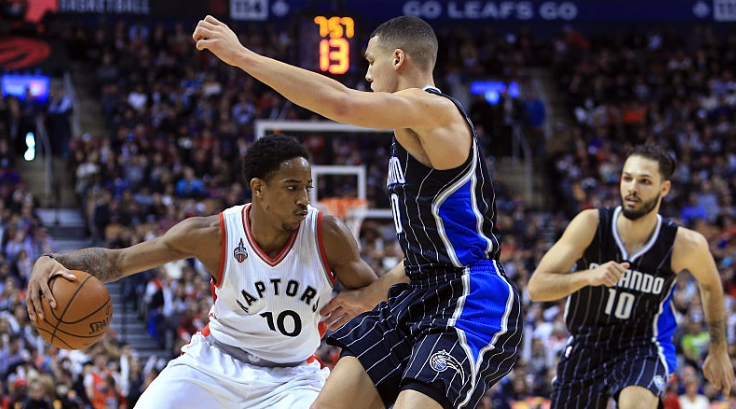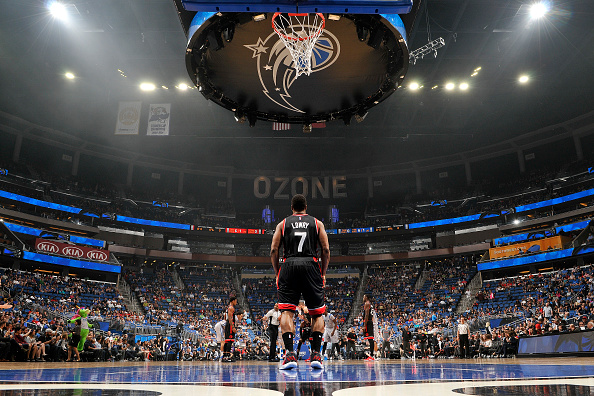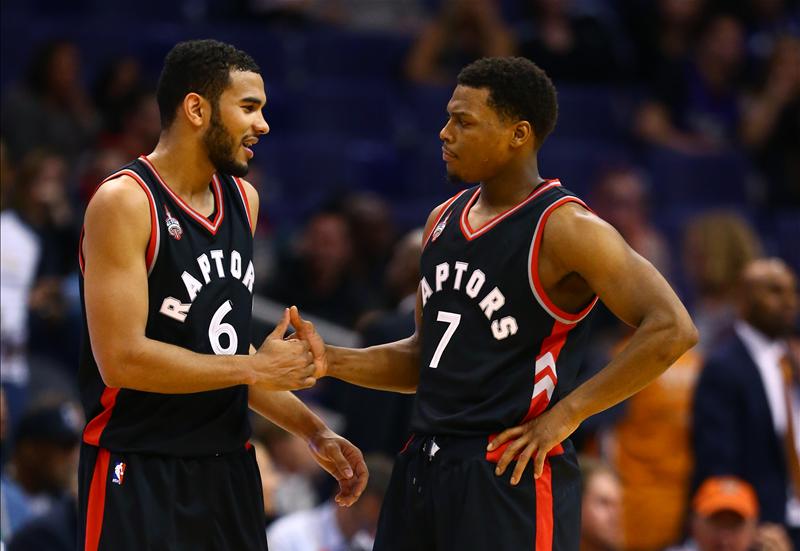In a seemingly meaningless mid-December game that involved the Toronto Raptors, a team with conference finals aspirations, and an Orlando Magic squad that has a bottom five Net Rating, the former predictably steam-rolled their opponent. However, the decisions made within that game are far more interesting than a 30 point blowout would suggest.
Starters with Siakam v. Patterson
This may come as a surprise to many, but there are drawbacks to Pascal Siakam playing in the starting lineup. This is not an indictment of the skill shown by Siakam, who has probably already exceeded expected production relative to his #27 selection by playing nearly 20 minutes a game on an upper tier team. He’s going to play in this league and be a part of lineups where they actually score more points than they give up. This is more of an issue regarding a superior player not playing with the proper lineup adequately enough. (It’s becoming a spectacle watching the ways in which Dwane Casey is avoiding starting Patrick Patterson. I am taking bets that as soon as the Raptors win the next tip off, he is going to call a timeout to swap Patterson for Siakam.)
The first quarter against Orlando showcased some of the issues that are present when Siakam is starting in place of Patterson.
The Raptors opened the first quarter by running “UCLA Stagger” a couple times.
The play starts with an entry pass from Lowry to DeRozan on the wing, which is followed by Lowry making a quick UCLA cut off the Valanciunas screen at the elbow. DeRozan then enters the ball into Valanciunas at the elbow and receives a screen of his own from Lowry, who quickly flipped after his own cut.
DeRozan then heads baseline, where he is met by Carroll and Siakam, ready to set staggered screens on the weak side of the floor. While this is happening, Lowry and Valanciunas engage in a DHO (dribble hand-off, effectively a pick and roll) on the strong side, giving Lowry momentum towards a curling DeRozan. Lowry then makes the pass to DeRozan who has to make the final decision on the play.
This is where the issue arose. When teams are ready for your scripted actions, they also know how to take advantage of your weaknesses. DeRozan is met by Serge Ibaka, who is “defending” Siakam, as he walls off the paint. DeRozan’s actual defender, Aaron Gordon, is trailing the play. That is an intended advantage created by having DeRozan curl off a staggered screen, which is quickly nullified by the lack of range Siakam has. Ibaka does not even second-guess his positioning in the paint. Even the slightest amount of hesitation in regards to which player he should situate himself in front of would have allowed DeRozan a cleaner look at the basket.
By comparing this play similar to situations with Patterson on the floor can help to illustrate the different mentality defenders must have depending on which power forward Casey decides to trot out.
Here, the Raptors ran Post DHO at the start of the 3rd quarter. DeRozan expertly turns the corner coming off of the mid-post handoff and is able to float the ball up easily (relative to the degree of difficulty DeRozan is comfortable with).
It is important to note how Ibaka is unable to simply wall off the paint as he did when Siakam was on the floor. Both Patterson and Siakam popped out to the corner as DeRozan curled towards the rim, but only Patterson’s gravity opened up the lane just enough for DeRozan to release a comfortable floater.
The lack of respect Siakam commands on the perimeter on offense not only impacts DeRozan’s ability to attack the rim, but Valanciunas’ as well.
Here, Valanciunas and Lowry engage in a side pick and roll going towards the middle of the floor, a desirable action that many defenses are structured to dissuade because of the havoc it can create. However, that action is far less desirable when the rolling screener can’t force the defense into making meaningful decisions.
Valanciunas can see how cluttered the paint is, as Siakam is positioned in the slot with DeRozan standing nearby. If Valanciunas rolls into the paint, he is going to be met far away from rim by Ibaka, as there is no damage defensively by stepping up and away from Siakam. This forces Valanciunas, who is a mediocre mid range shooter at best, to stop his run out of the area where he is most impactful.
By rearranging the screeners, and having Siakam replaced with Patterson, it is easy to spot where the increased desirability on offense kicks in.
Here, two defenders are drawn to the ball after a screen, just like the prior scenario. However, because one of the two available screeners is respected as a perimeter shooter, the issue of a big man cluttering the paint by hanging around the slot area is no longer an actual issue. Patterson pops out to the three point line, an area where Patterson can produce far more points when compared to Valanciunas’ mid range jumper.
The defensive issues associated with playing Siakam over Patterson were also on display against Orlando. While neither are brutes who can stone-wall opposing post players, Siakam’s tendency to get shoved under the rim hurt him early. Patterson, who also allowed Ibaka to score from the post, forced far more difficult shots that are a less sustainable source of points.
Additionally, Patterson is a superior defender in pick and roll situations. Again, not an indictment of SIakam, Patterson is just that good. He’s a versatile and willing defender that very rarely makes mistakes. He is one of the more consistent hard-hedging big men, while also being capable of switching or dropping back and containing.
Exploiting Orlando’s shooting
The Raptors successfully exploited the lack of shooting Orlando had on the floor throughout the game. Staying on the topic of pick and roll coverage, the Raptors continued their recent trend of “high-walling” side pick and rolls and sending extra help from the weak side to tag the roller. This is especially effective when the weak side player being abandoned is a poor three-point shooter, such as Aaron Gordon.
I would say the jury is still out on this type of defensive scheme for the Raptors, specifically with Valanciunas on the floor. The times it doesn’t work stick out in a viewer’s mind far more than the times where simply nothing happens. It is probably best deployed as a matchup-driven scheme, rather than a one-size-fits all sort of thing.
Another way the Raptors leveraged the Magic’s lack of shooting was by aggressively digging down on post ups. Casey was worried about the Nikola Vucevic – Lucas Nogueira matchup between backup bigs, and rightfully so.
To combat this, they dug down on post ups as often as they could. With perimeter players such as Elfrid Payton and Aaron Gordon on the floor, there was very little consequence to abandoning for Raptors defenders who left their assignment to dig down aggressively and even double the post.
At worst, the remaining Raptors perimeter defenders had to feint towards the open non-perimeter threat so they can quickly recover back to their real assignment
Misc. Notes
Fred VanVleet had a really nice game, you can see he’s a composed and intelligent player. Here, he attacks ICE coverage on a side pick and roll. He knows that hes driven as far down the baseline as he can, so he swings the ball to the screener and out to Lowry. He quickly goes into a pin down to get the ball back, a relatively common way of combating ICE coverage. Most defenders will loosen up once their assignment has given up the ball after a pick and roll, and VanVleet attacked that by curling very hard off of the catch to attack the rim.
He also just shows pure effort, something Jeff Green hilariously refuses to do consistently.
Green picked up his dribble for no apparent reason, made eye contact with Patterson who backed off into the post, and continued to just pass it to him. The Jeff Green Experience knows no bounds.
The Raptors made an unusually great read out of their scarcely used motion offense. Traditionally, as the ball swings from one side of the court to the other in Motion Weak, a low post player will receive a cross screen along the baseline to help establish post position. Biyombo denied Valanciunas this liberty by completely overplaying that side of the screen, so Valanciunas flashed into the middle of the floor near the bucket and Lowry hit him with a fantastic pass. These guys are more than capable of a read-and-react offense being used more frequently. Though, one of their best attributes is their infrequent turnovers, which could be at risk in that situation.
One of the Raptors’ most frequently used actions, an AI (Allen Iverson) cut, is a part of their base offense that can get a little stagnant. Among their counters when the first option isn’t open is a weakside pindown. They even flowed into a second layer of that counter by entering the ball into the post once the down screen proved fruitless for Carroll. Spontaneous reads like these keep the defense preoccupied with what they think is an inevitable force-feed to DeRozan.
The Raptors knew coming into their matchup against Orlando that DeRozan would be checked by a bulkier Gordon. Whenever DeRozan has an less than favourable matchup, the Raptors like to push the ball a bit more in transition and run a 2 / 1 or 2 / 3 screen to free DeRozan up onto a smaller player. He’s able to either create separation between his original matchup, Gordon, forcing him to recover and be more prone to biting on a pump fake, or get into the post against smaller wings and guards, like Meeks, who he can lose for a drive to the rim.
Conclusion
After a brutal first quarter, the Raptors turned the game around and blew out the lowly Magic like they should. A mixture of opening up their own spacing, while also leveraging the Magic’s lack of spacing acted as a catalyst to push the Raptors past the Magic.



